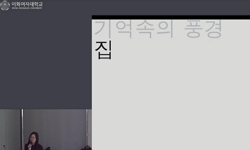Andong Dam, which was completed in 1976, is a multi-purpose dam constructed for flood control downstream of the Nakdonggang River and for agricultural, industrial and living water purposes. Andong Dam is a place of memory that preserves the pain of th...
http://chineseinput.net/에서 pinyin(병음)방식으로 중국어를 변환할 수 있습니다.
변환된 중국어를 복사하여 사용하시면 됩니다.
- 中文 을 입력하시려면 zhongwen을 입력하시고 space를누르시면됩니다.
- 北京 을 입력하시려면 beijing을 입력하시고 space를 누르시면 됩니다.
https://www.riss.kr/link?id=A107292351
- 저자
- 발행기관
- 학술지명
- 권호사항
-
발행연도
2021
-
작성언어
Korean
-
주제어
기억 ; 유희 ; 장소성 ; 안동댐 ; 문화적 재생 ; Memory ; Play ; Placeability ; Andong Dam ; Cultural Regeneration
-
등재정보
KCI등재
-
자료형태
학술저널
-
수록면
75-82(8쪽)
-
KCI 피인용횟수
0
- 제공처
-
0
상세조회 -
0
다운로드
부가정보
다국어 초록 (Multilingual Abstract)
Andong Dam, which was completed in 1976, is a multi-purpose dam constructed for flood control downstream of the Nakdonggang River and for agricultural, industrial and living water purposes. Andong Dam is a place of memory that preserves the pain of the victims, and it is a place where the daily lives, precious memories, and small stories of parents and neighbors are present in the water. However, the memory of the people in the ruins is not useless and disappears. Therefore, the purpose of this study is to reflect the location of Andong Dam. To this end, Andong Dam was designed to create a place of memories that preserved the pain of the sinking and a fun place that incorporated new contents. Attention was paid to Johan Huizinga's Homorudens, playing human beings, and the direction of planning was set based on the fact that culture itself was not an element of culture, but a characteristic of play. To this end, the theoretical discussions and case analysis on the place of memory, amusement, place and cultural regeneration were conducted to derive implications and analyze the current status of Andong Dam. Based on this, the Andong Dam's resources, 'water', was reinterpreted and named 'water feast' by adding the meaning of 'a feast held in a very grand manner'. Accordingly, the Andong Dam space design and operation program were presented with memories and entertainment. The purpose was to increase the meaning and value of Andong Dam by encouraging visitors to participate and experience so that it can be integrated with the place. It is expected that this will encourage tourists to stay and contribute to enhancing the local brand and revitalizing the economy.
참고문헌 (Reference)
1 John Huizinga, "호모루덴스" 까치글방 2018
2 박소영, "현대사회의 호모루덴스" 47 : 2018
3 강나현, "하이메 아욘 공간의 비일상적 특성 연구" 한국공간디자인학회 12 (12): 115-125, 2017
4 문화살롱 공, "포천 도롱이 집 이주 프로젝트" 경기문화재단 2010
5 이경숙, "지역문화자원으로 바라본 안동댐 수상공연콘텐츠 기획" 사단법인 아시아문화학술원 11 (11): 1027-1036, 2020
6 정희선, "종교 공간의 장소성과 사회적 의미의 관계: 명동성당을 사례로" 한국도시지리학회 7 (7): 97-110, 2004
7 이석환, "장소와 장소성의 다의적 개념에 관한 연구" 32 (32): 1997
8 Edwards Ralph, "장소와 장소상실" 논형 2005
9 최막중, "장소성의 형성요인과 경제적 가치에 관한 실증 분석: 대학로 로데오 거리 사례를 중심으로" 36 (36): 2001
10 전진성, "역사기 기억을 말하다" 휴머니스트 2005
1 John Huizinga, "호모루덴스" 까치글방 2018
2 박소영, "현대사회의 호모루덴스" 47 : 2018
3 강나현, "하이메 아욘 공간의 비일상적 특성 연구" 한국공간디자인학회 12 (12): 115-125, 2017
4 문화살롱 공, "포천 도롱이 집 이주 프로젝트" 경기문화재단 2010
5 이경숙, "지역문화자원으로 바라본 안동댐 수상공연콘텐츠 기획" 사단법인 아시아문화학술원 11 (11): 1027-1036, 2020
6 정희선, "종교 공간의 장소성과 사회적 의미의 관계: 명동성당을 사례로" 한국도시지리학회 7 (7): 97-110, 2004
7 이석환, "장소와 장소성의 다의적 개념에 관한 연구" 32 (32): 1997
8 Edwards Ralph, "장소와 장소상실" 논형 2005
9 최막중, "장소성의 형성요인과 경제적 가치에 관한 실증 분석: 대학로 로데오 거리 사례를 중심으로" 36 (36): 2001
10 전진성, "역사기 기억을 말하다" 휴머니스트 2005
11 장창래, "안동댐 하류 하천에서 사주의 재현 모의" 대한토목학회 30 (30): 379-388, 2010
12 최인호, "스토리텔링을 활용한 장소마케팅에 관한 탐색적 연구" 한국관광학회 32 (32): 411-429, 2008
13 신승호, "수몰지역 기록화 방안에 관한 연구" 명지대학교 기록정보과학전문대학원 2012
14 정지은, "문화적 도시재생을 활용한 문화관광지 사례 연구 : 일본 야네단 마을을 중심으로" 한국문화산업학회 20 (20): 11-21, 2020
15 이경숙, "문화적 관점에서 본 안동 교량 유휴공간 재창조 모델" 한국문화공간건축학회 (67) : 111-118, 2019
16 Don Mitchell, "문화와 문화정치" 살림출판사 2001
17 이현아, "다층적 기억: 재생의 패러다임과 메모리얼 건축의 변화 양상: 윤동주문학관을 중심으로" 서울대학교 2015
동일학술지(권/호) 다른 논문
-
박물관 증축유형에 따른 관람자 이용공간 위계변화에 관한 기초연구- 국립중앙박물관 소속 박물관을 분석중심으로 -
- 한국문화공간건축학회
- ZHAO XIAOLONG
- 2021
- KCI등재
-
지역 공립 박물관 입지 선정을 위한 AHP 적용 사례 연구
- 한국문화공간건축학회
- 윤성규
- 2021
- KCI등재
-
경북 봉화 청암정과 석천정사의 건축 공간과 경관 구성에 관한 연구
- 한국문화공간건축학회
- 정연상
- 2021
- KCI등재
-
- 한국문화공간건축학회
- 우성호
- 2021
- KCI등재
분석정보
인용정보 인용지수 설명보기
학술지 이력
| 연월일 | 이력구분 | 이력상세 | 등재구분 |
|---|---|---|---|
| 2026 | 평가예정 | 재인증평가 신청대상 (재인증) | |
| 2020-01-01 | 평가 | 등재학술지 유지 (재인증) |  |
| 2017-01-01 | 평가 | 등재학술지 유지 (계속평가) |  |
| 2013-01-01 | 평가 | 등재학술지 선정 (등재후보2차) |  |
| 2012-01-01 | 평가 | 등재후보 1차 PASS (등재후보1차) |  |
| 2011-01-01 | 평가 | 등재후보학술지 유지 (등재후보2차) |  |
| 2010-01-01 | 평가 | 등재후보 1차 PASS (등재후보1차) |  |
| 2009-01-20 | 학술지명변경 | 한글명 : 한국문화공간건축학회 -> 한국문화공간건축학회논문집 |  |
| 2008-01-01 | 평가 | 등재후보학술지 선정 (신규평가) |  |
학술지 인용정보
| 기준연도 | WOS-KCI 통합IF(2년) | KCIF(2년) | KCIF(3년) |
|---|---|---|---|
| 2016 | 0.28 | 0.28 | 0.25 |
| KCIF(4년) | KCIF(5년) | 중심성지수(3년) | 즉시성지수 |
| 0.23 | 0.23 | 0.406 | 0.25 |




 KCI
KCI






